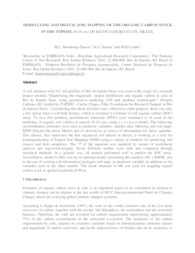Modelling and digital soil mapping of the organic carbon stock in the topsoil (0-10 cm) of Rio de Janeiro State, Brazil.
Modelling and digital soil mapping of the organic carbon stock in the topsoil (0-10 cm) of Rio de Janeiro State, Brazil.
Autoria: MENDONÇA-SANTOS, M. de L.; SANTOS, H. G. dos; COELHO, M. R.
Resumo: A soil database with 431 soil profiles of Rio de Janeiro State was used in the scope of a research project entitled "Quantifying the magnitude, spatial distribution and organic carbon in soils of Rio de Janeiro State, using quantitative modeling, GIS and database technologies" (Projeto Carbono_RJ, funded by FAPERJ - Carlos Chagas Filho Foundation for Research Support in Rio de Janeiro State). Considering that these soil data were collected to other purpose, there was only a few sparse data to soil bulk density, which is essential to estimate of soil organic carbon (SOC) stock. To face this problem, pedotransfer functions (PTFs) were estimated to be used in the modeling of organic soil carbon of topsoil (0-10 cm), using s.c.o.r.p.a.n model. The following environmental correlates were used as predictor variables: satellite data, lithology and soil maps, DEM (Digital Elevation Model) and its derivatives as source of information for these variables. This dataset, that represents the best organized soil dataset in Brazil, is working as a trial for learning/teaching of Digital Soil Mapping (DSM) using a variety of methods for predicting soil classes and their properties. The "f" of the equation was modeled by means of multilinear analysis and regression-kriging. Seven different models were built and compared through statistical methods. In a general way, all models performed well to predict the SOC stock. Nevertheless, model 6 (M6) was an exceptional model, presenting the smallest AIC e RMSE, due to the use of existing soil information (polygon soil map) as predictor variable, in addition to the variables used in the other models. The result obtained in M6 was used for mapping topsoil carbon stock at spatial resolution of 90 m.
Ano de publicação: 2008
Tipo de publicação: Artigo em anais e proceedings
Unidade: Embrapa Solos
Palavras-chave: Carbono, Estoque, Soil organic carbon
Observações
1 - Por padrão são exibidas publicações dos últimos 20 anos. Para encontrar publicações mais antigas, configure o filtro ano de publicação, colocando o ano a partir do qual você deseja encontrar publicações. O filtro está na coluna da esquerda na busca acima.
2 - Para ler algumas publicações da Embrapa (apenas as que estão em formato ePub), é necessário ter, no celular ou computador, um desses softwares gratuitos. Sistemas Android: Google Play Livros; IOS: iBooks; Windows e Linux: software Calibre.
Acesse outras publicações
Acesse a Base de Dados da Pesquisa Agropecuária (BDPA) para consultar o acervo completo das bibliotecas da Embrapa.

